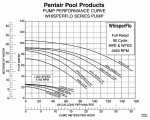Guys,
I am looking to get some real life experience input from members here who had the chance to verify a pump head curve.
Are the pump curves from manufacturer honestly accurate in the upper last 10% of the maximum head ?
I am asking this because I just received a Pentair Whisperflo pump curve table using 50hz electric supply and 2,950 RPPM and it is offering the exact performance with the USA version 60hz at 3,450 RPM. I am confused. Unfortunately I do not have the electrical data to verify BHP. It just does not make sense.
I been looking at SF rating and 1.95 is about the highest on the market for Pentair of 60hz. I am looking at the highest SF of 1.95 for Whisperflo 0.5HP 60hz, no way the 50hz unit can produce similiar performance curve if having the same 1.95 SF. My Pentair Superflo 1.5HP in fact is only a SF 1.10 for a 50hz unit as per name plate, while USA 60hz version is SF 1.65 and I don't have the pump curve of Superflo series.
I am not an electrical engineer but I know enough that a 60hz pump gives better output than a 50 hz one assuming it is a 50/60hz unit. A 2,950 RPM pump must use more energy to produce exact save performance curve of a 3,450 RPM. The manufacturer is the same, the product family is the same, so I doubt the impeller efficiency would be any different.
So what am I missing here ?
Sorry, I don't know how to convert the 50hz curve from PDF to GIF, it will be easy to compare if both are shown as GIF or JPEG
Thanks very much.
I am looking to get some real life experience input from members here who had the chance to verify a pump head curve.
Are the pump curves from manufacturer honestly accurate in the upper last 10% of the maximum head ?
I am asking this because I just received a Pentair Whisperflo pump curve table using 50hz electric supply and 2,950 RPPM and it is offering the exact performance with the USA version 60hz at 3,450 RPM. I am confused. Unfortunately I do not have the electrical data to verify BHP. It just does not make sense.
I been looking at SF rating and 1.95 is about the highest on the market for Pentair of 60hz. I am looking at the highest SF of 1.95 for Whisperflo 0.5HP 60hz, no way the 50hz unit can produce similiar performance curve if having the same 1.95 SF. My Pentair Superflo 1.5HP in fact is only a SF 1.10 for a 50hz unit as per name plate, while USA 60hz version is SF 1.65 and I don't have the pump curve of Superflo series.
I am not an electrical engineer but I know enough that a 60hz pump gives better output than a 50 hz one assuming it is a 50/60hz unit. A 2,950 RPM pump must use more energy to produce exact save performance curve of a 3,450 RPM. The manufacturer is the same, the product family is the same, so I doubt the impeller efficiency would be any different.
So what am I missing here ?
Sorry, I don't know how to convert the 50hz curve from PDF to GIF, it will be easy to compare if both are shown as GIF or JPEG
Thanks very much.




